If you’re involved in website promotion – whether for your own site or a client’s – you’ve likely noticed how search engines have evolved over the past two years. Traditional search results are being replaced by AI-powered assistants that generate direct answers right on the results page.
This shift demands a new approach to SEO. In this article, LinkBuilder.com explains what GEO SEO is and provides guidance on how to implement it effectively.
What Is Generative Engine Optimization (GEO) and Why It Matters
Generative Engine Optimization (GEO) is a modern approach to website optimization that focuses on generative search systems. Unlike classic SEO, which aims for top rankings, GEO ensures AI systems use your content as a source for their answers.
The goal of GEO is to make your content a preferred source for AI. When users ask a question, generative search engines compile answers from multiple sources – your job is to ensure your site is one of them.
This is crucial because an increasing number of users are turning to AI for information. According to reports from JS Interactive, Exploding Topics, The Verge, and Digital Information World, ChatGPT now has 600 million active users as of July 2025.
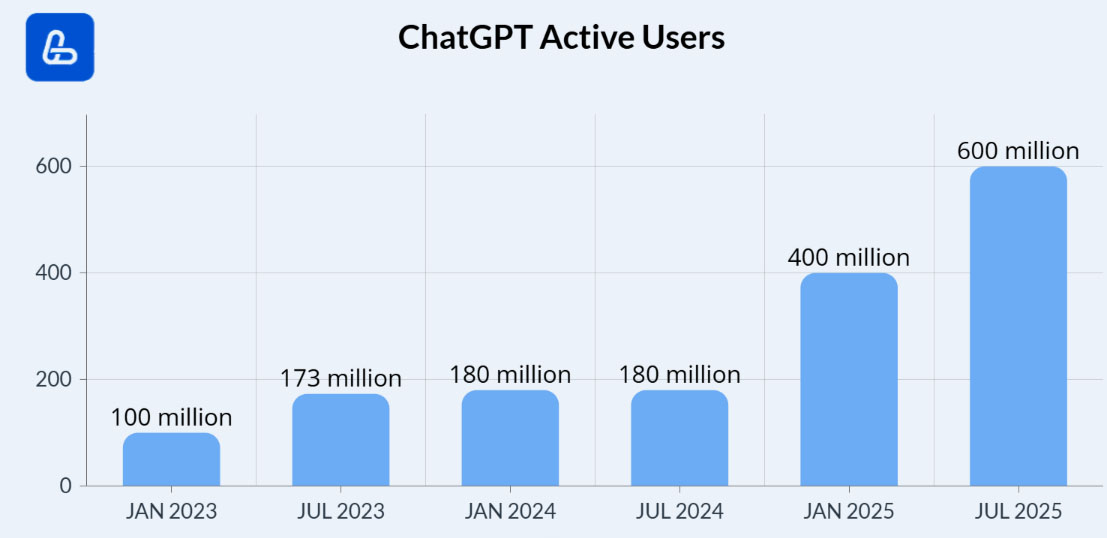
How AI Is Changing Search Engines
Search engines are evolving rapidly. Google, Bing AI, and Perplexity now use generative AI to provide direct answers.
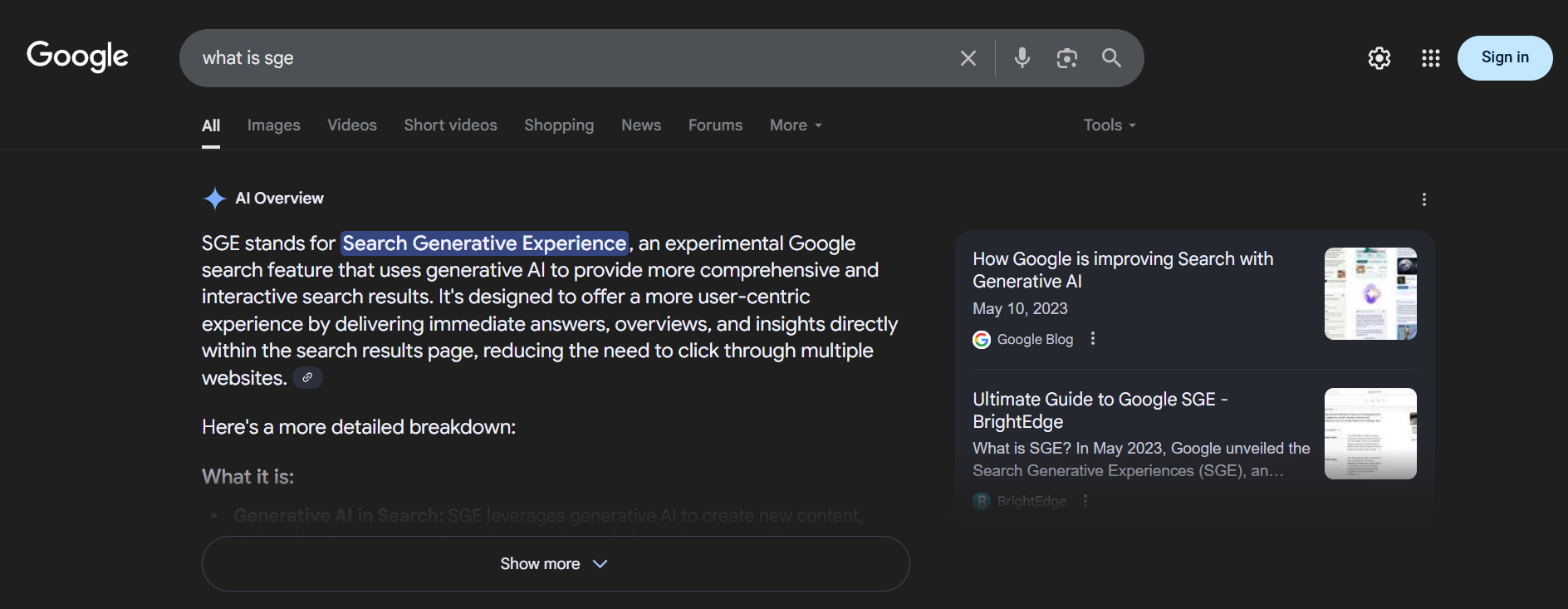
What does this mean for website owners? Previously, users would browse through 10 results and click on a link. Now, they often get complete answers directly in search results, without ever needing to visit a website. Studies show 30-40% of queries are resolved this way.
Here’s how generative search works:
- A user asks a question.
- AI scans multiple sources.
- It generates a summarized answer.
- It cites the original sources.
Even if your site is referenced, a click isn’t guaranteed.
Traditional SEO remains effective, but its effectiveness is gradually declining. AI reduces click-through rates (CTR) for organic results, and generative answers "steal" traffic even from top-ranked pages.
Ranking factors in generative search differ from classic SEO. Keywords, backlinks, and meta tags still matter – but they’re no longer enough. Success now depends on how AI evaluates and uses your content.
Key Differences Between Major Optimization Types
Most marketers understand the meaning of engine optimization, but GEO requires a deeper look at how different approaches compare.
SEO: Classic Search Engine Optimization
Goal: Rank high in search results for target queries.
Key Components:
- Technical SEO (speed, mobile-friendliness, site structure)
- Content Optimization (keywords, meta tags, readability)
- Off-Page SEO (backlinks, domain authority)
SEO is a proven method, but AI is changing how it works.
Answer Engine Optimization (AEO): Optimizing for Featured Snippets
Goal: Get content featured in direct answer blocks (e.g., Google’s Featured Snippets).
Key Features:
- Q&A-style content
- Structured data markup
- Clear definitions and lists
AEO was a stepping stone to generative search. Unlike GEO, AEO simply highlights existing content – it doesn’t generate new answers.
Geo SEO: Local Search Optimization
Don’t confuse GEO (Generative) with Geo SEO (Geographic). The latter focuses on local visibility.
Key Tactics:
- Local keywords (e.g., "best coffee shop in [city]")
- Google My Business optimization
- Local backlinks and citations
Geo SEO is essential for brick-and-mortar businesses but is unrelated to AI-driven search.
Generative Engine Optimization (GEO): AI-Driven Promotion
Goal: Make your content a primary source for AI-generated answers.
Key Strategies:
- Authoritative, in-depth content
- Clear structure for AI readability
- Expert insights and data-backed analysis
Unlike SEO, where rankings matter, GEO focuses on being cited by AI.
Comparison Table
| Criterion | SEO | AEO | Geo SEO | GEO |
|---|---|---|---|---|
| Main Goal | Top rankings | Featured snippets | Local visibility | AI citations |
| Key Metrics | Traffic, rankings, CTR | Snippet appearances | Local search presence | AI answer citations |
| Content Focus | Keywords, topical coverage | Q&A format | Local relevance | Expertise, depth, structure |
| Technical Needs | Standard SEO best practices | Schema markup | Local business listings | Semantic clarity, E-E-A-T signals |
These methods aren’t mutually exclusive – combining them yields the best results.
How Generative Search Systems Work

Unlike traditional search engines that simply return a list of links, generative engine AI analyzes multiple sources and synthesizes a response to your query.
What is generative SEO? It’s a set of AI optimization strategies designed to ensure your content is selected as a source for these AI-generated answers.
The Technology Behind Generative Search Engines: Google SGE, Bing AI, and Other AI Platforms
Modern generative search systems rely on large language models (LLMs) capable of understanding and generating human-like text. Here are the leading platforms in this space:
Google Search Generative Experience (SGE)
Google SGE is an experimental feature that uses a generative AI engine to provide summarized answers directly in search results.
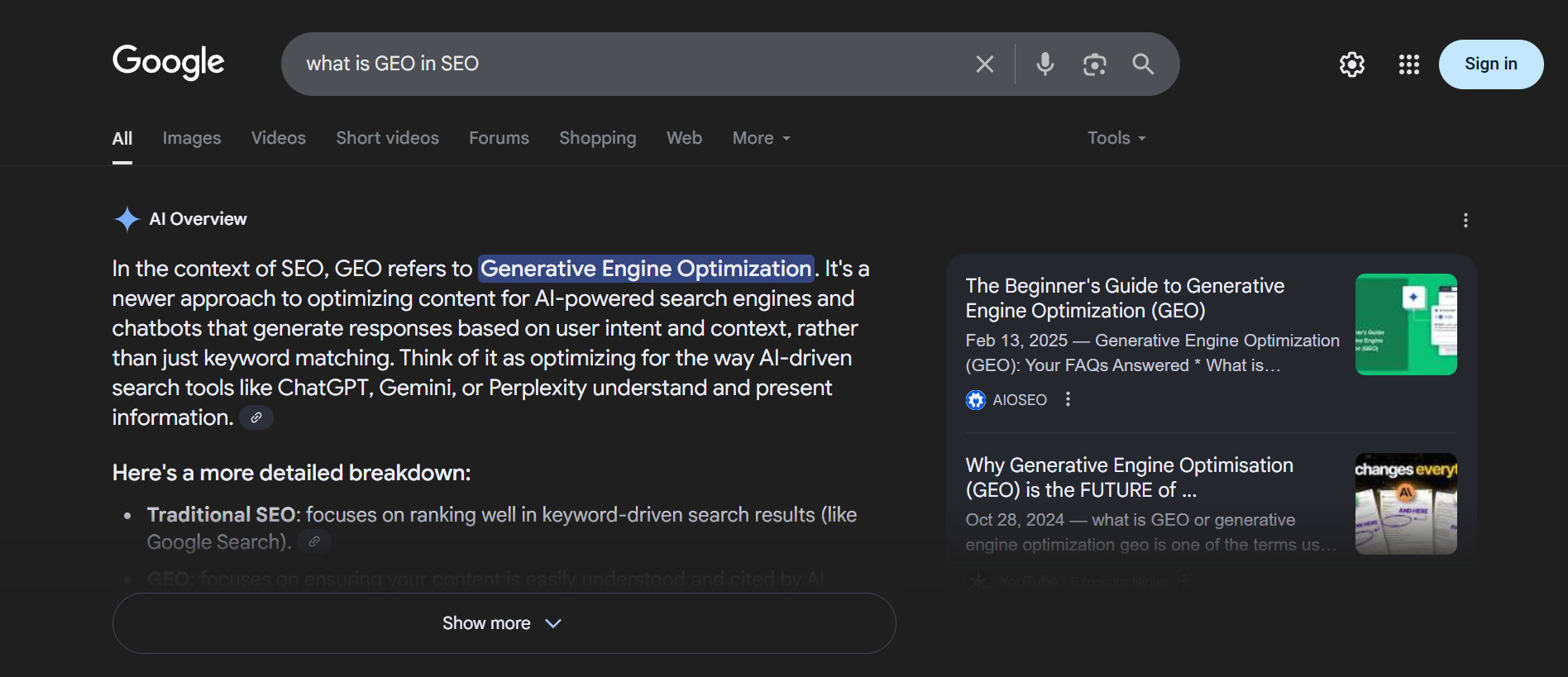
SGE processes your query and generates an AI response based on information from various web pages, with citations to the original sources.
Microsoft Bing AI (Copilot)
Bing AI, powered by OpenAI’s GPT-4, offers interactive search with conversational responses and cited sources.
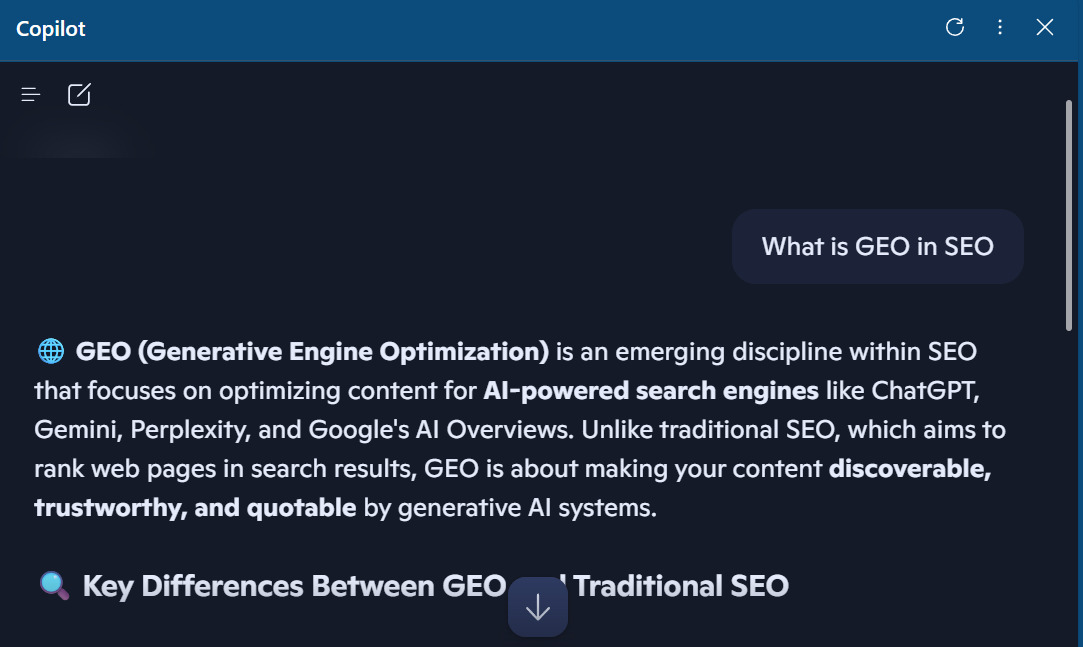
Unlike traditional search, Bing AI operates in a separate window – accessible via the Copilot icon in Microsoft Edge.
Other AI Search Platforms
- Perplexity AI – A specialized generative engine providing detailed, sourced answers.
- You.com – Blends traditional search with generative AI and SEO capabilities.
All these platforms follow a similar approach: scanning the web, indexing content, and using advanced AI optimization algorithms to craft responses.
To see if your content appears in AI results, manually test relevant queries in these systems.

How Generative Systems Form Answers
Generative search engines operate differently from classic ones. Here’s their process:
- Understanding intent – They analyze context, query history, and indirect signals to grasp user needs.
- Information synthesis – Instead of ranking pages, they extract and combine data from multiple sources.
- Content quality evaluation – They assess site authority, expertise, relevance, and adherence to E-E-A-T principles.
- Contextualization – Answers adapt based on location, language, device, and session history.
- Continuous learning – Systems improve by tracking user engagement and following up with targeted questions.
These principles are crucial for achieving success with generative AI SEO.
Citations and Source Attribution
Modern generative systems prioritize transparency in sourcing:
- Direct source links – Key statements are hyperlinked (e.g., Google SGE).
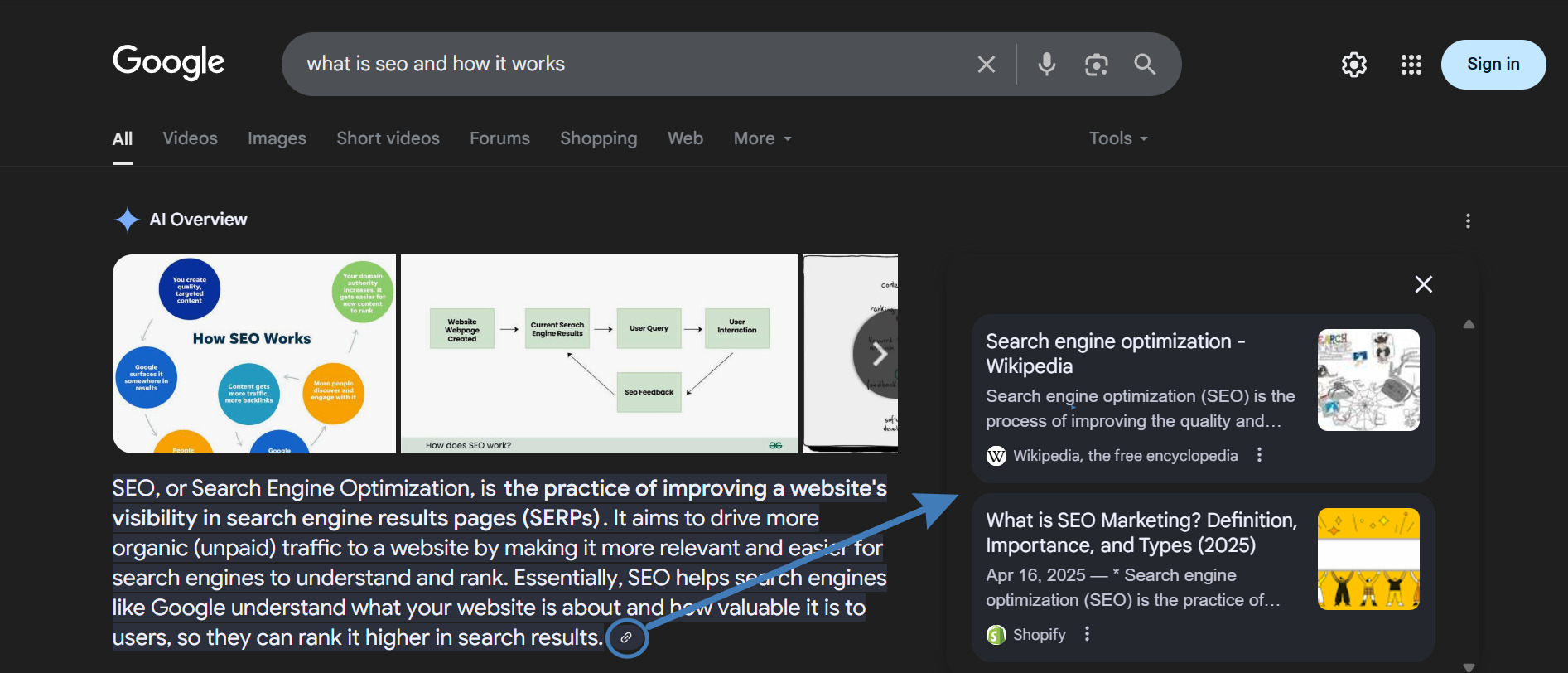
- Visual source displays – Some platforms show website thumbnails.
- Data attribution – Statistics and quotes are linked to primary sources for verification.
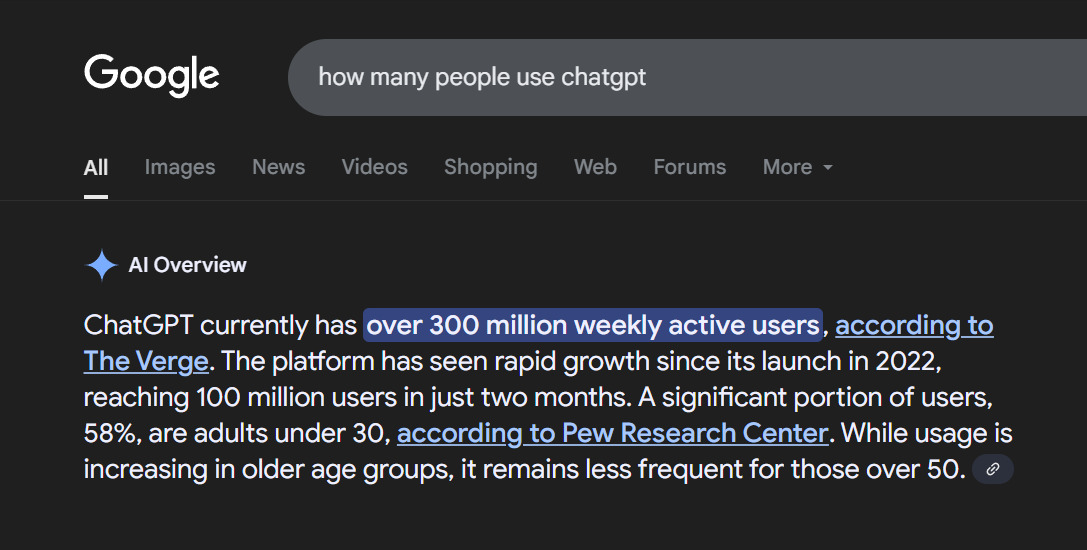
Generative SEO selects sources based on:
- Domain authority
- Content completeness
- Factual accuracy
- Freshness
- Structured formatting
For SEOs, citations offer new opportunities – even unclicked mentions boost brand authority.
Key Components of a Winning GEO Strategy
Generative engine optimization requires a holistic approach. Here’s how to make your content AI-friendly:
Creating Generative-Optimized Content

If you're accustomed to traditional SEO, you'll need to adjust your approach for generative search engines. It's no longer just about ranking higher – it's about becoming the source that AI chooses to pull answers from.
Whether you handle content yourself or use professional content optimization services, the fundamentals of GEO stay the same. Here's what really matters:
Getting the Facts Straight
AI systems crave precision like a fact-checker at a news desk. They'll pick content that's:
- Packed with exact numbers
- Backed by current stats you can trace to their source
- Full of real-world examples instead of vague generalities
Making Content AI-Friendly
Think of structuring content like organizing a filing cabinet – the neater it is, the easier AI can find what it needs:
- Clear headings that create a roadmap (H1, H2, H3)
- Related ideas grouped logically
- Bullet points that make lists scan-friendly
- Key terms bolded or explained upfront
Going Deep on Topics
Surface-level content won't cut it anymore. You need to:
- Answer all the natural follow-up questions a reader might have
- Show multiple sides of an issue when relevant
- Explain industry jargon like you're talking to a smart newcomer
The Power of Q&A Format
Q&As are gold for generative search. Try:
- Turning subheadings into actual questions people ask
- Giving direct answers right under each question
- Adding an FAQ section that covers bonus material
Pro tip: Mine forums or Google's "People Also Ask" boxes to find exactly what questions your audience cares about.
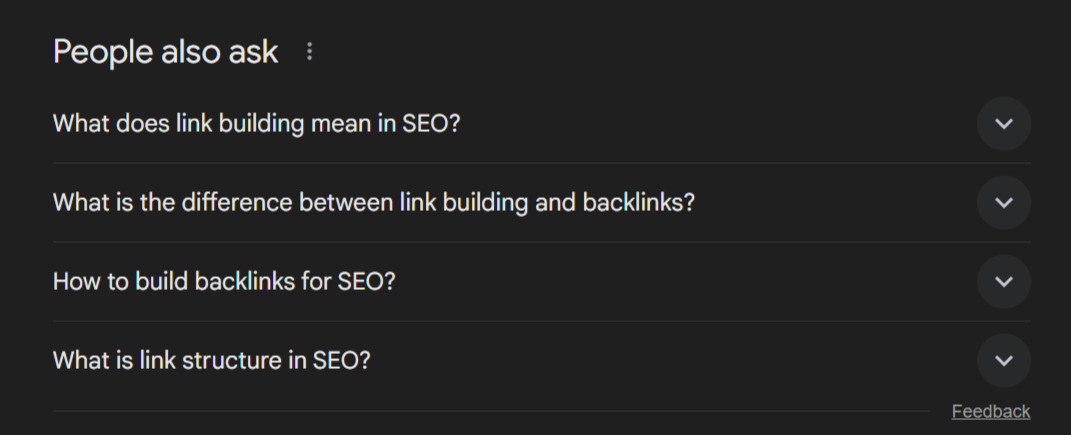
Speaking Like a Human
Since AI handles more voice searches and casual queries:
- Work in long-tail phrases like "how do I fix slow website loading"
- Structure content around problems first, keywords second
Mixing Up Your Formats
Different content types give AI more ways to use your material:
- Comparison tables for products or services
- Charts that turn number soup into visual snacks
- Step-by-step walkthroughs with clear numbering
- Definition boxes for technical terms
Proving You Know Your Stuff
AI wants trustworthy sources, so:
- Quote recognized experts in your field
- Link to respected studies or reports
- Explain how you gathered any original data
- Showcase author bios with relevant credentials
Why E-E-A-T Matters More Than Ever
Those four letters (Experience, Expertise, Authoritativeness, Trustworthiness) are your report card with AI systems:
- Experience – AI loves content that looks like real-world use (case studies, personal stories)
- Expertise – Can you explain complex topics simply? That's the test.
- Authoritativeness – Other sites linking to you tell AI you're a big deal.
- Trustworthiness – Clear sourcing and update dates build confidence.
Structured Data
This hidden code helps AI "get" your content faster. Most valuable for GEO:
- FAQ markup – Tags your Q&A content for AI to snack on
- HowTo markup – Turns recipes/guides into AI-ready steps
- Article markup – Shows who wrote what and when
- Product markup – Makes e-commerce items AI-friendly
The Technical Side of GEO

When it comes to GEO (Generative Engine Optimization), your site's technical health isn't just important – it's the foundation that determines whether AI systems will even notice your content. These engine optimization strategies require a different approach than traditional technical SEO.
Rethinking Technical SEO for AI Search
Your website's infrastructure needs special tuning for generative search engines. This isn't just about tweaking – it's about rebuilding key aspects of your technical approach from the ground up with AI optimization in mind.
Critical Technical Factors for GEO Success:
- Speed That Impresses AI
- Core Web Vitals aren't just user-friendly – they're AI-friendly
- Faster loading = Better chances of appearing in AI-generated answers
- Content Architecture That Tells a Story
- AI doesn't just read pages – it understands how they connect
- Think of your site structure as a map AI needs to navigate
- Making Sure AI Can Access Everything
- Audit your robots.txt – don't accidentally hide gold from AI crawlers
- XML sitemaps should highlight your most valuable content
- HTML sitemaps help both users and AI find what matters
- HTML That Speaks AI's Language
- Semantic HTML5 tags (<article>, <section>) are like signposts for AI
- Proper heading hierarchy (H1-H6) creates an instant outline
- Lists and tables help AI digest complex information
- The JavaScript Dilemma
- AI struggles with content that relies too heavily on JavaScript
- Server-side rendering (SSR) keeps your content visible
- Critical information should never depend on scripts loading
- Building AI-Friendly Data Access Points
- Public APIs let AI "drink directly from the source"
- JSON/XML formats are like AI comfort food
- Create dedicated endpoints for different content types
Mobile Optimization for the Voice Search Era
With most AI queries coming from mobile devices, your GEO digital marketing strategy needs mobile-first thinking:
- Design for thumbs, not mouse pointers
- Write conversationally – like you're answering a friend's question
- Voice search favors natural, question-style phrasing
- Kill anything that slows mobile performance
Your Practical GEO Implementation Guide
Now that we've covered the theory of generative AI SEO, let's get to practice. Here's your step-by-step playbook for optimizing sites for AI search.
The GEO Audit: Is Your Site AI-Ready?
Before diving into engine optimization services, you need a clear understanding of your current standing.
- Tracking Your AI Appearances
- Make a list of your key terms
- Check which generate AI answers in search
- Note if/when your site appears in these answers
- Use tools to automate tracking
To make this process easier, use our latest development – the AI Ranker tool, which helps you track your website's presence in generative responses.
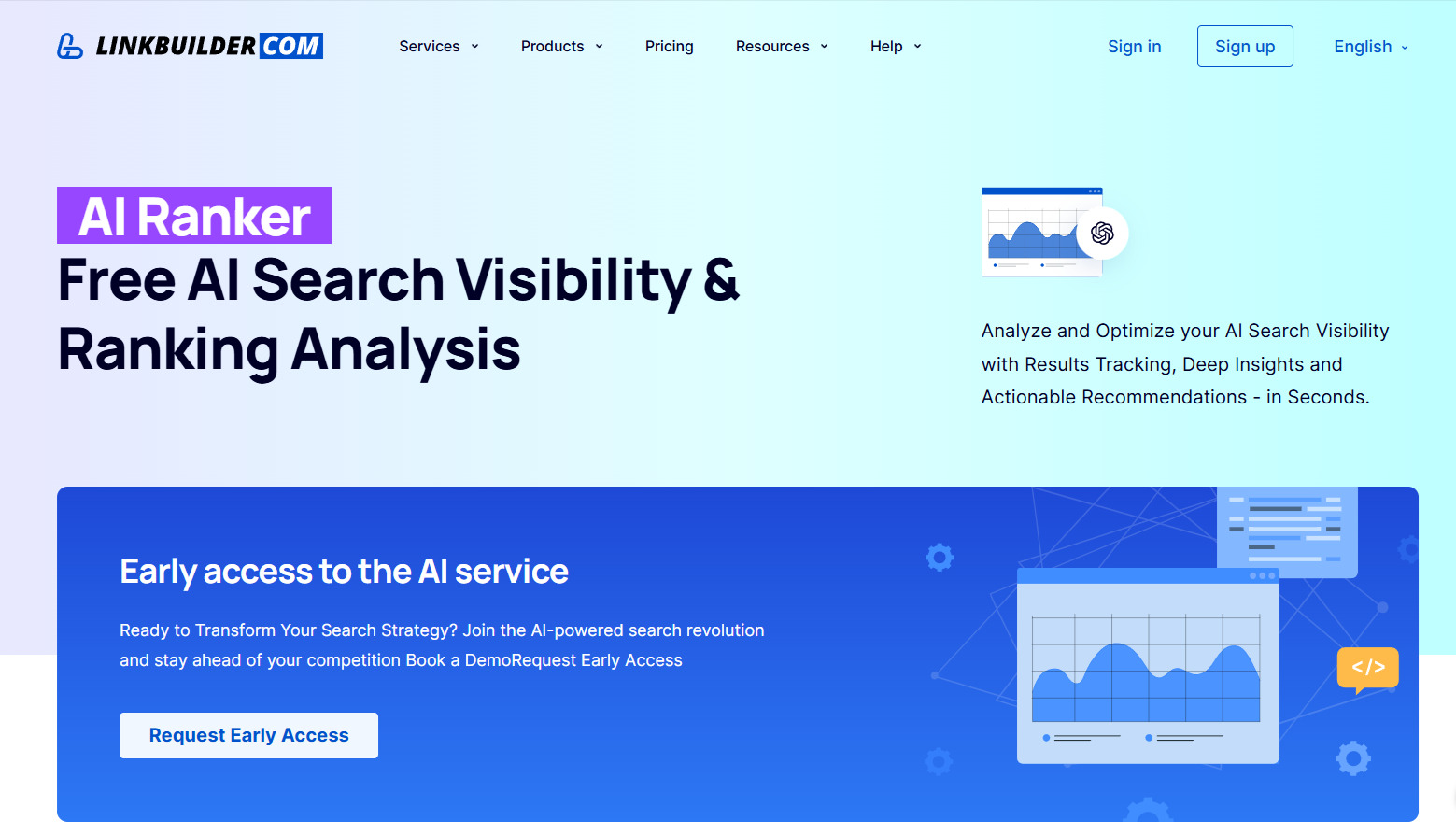
AI Ranker helps you generate the most popular queries and analyze them with ChatGPT to see which pages are cited in AI responses. You can use this engine optimization service for free with a LinkBuilder.com subscription.
- Content Evaluation Through AI Lenses
- Fact-check your own content – AI spots fluff instantly
- Structure matters: Are headings logical? Is the information easy to parse?
- Check for E-E-A-T signals (author bios, citations, update dates)
- Technical Health Check
- Run Core Web Vitals diagnostics
- Test mobile load speeds
- Verify structured data implementation
- Audit crawlability issues
- Competitive AI Analysis
- Identify which competitors AI prefers
- Analyze their most-cited content structures
- Find gaps in their coverage you can own
Building an AI-First Content Strategy
After completing your GEO audit, it's time to build a content strategy designed explicitly for generative search queries. This isn't your typical content planning – it requires a fundamentally different approach. Here's how to create an effective generative engine optimization (GEO) content strategy:
Finding What AI Wants to Share
Not all queries trigger AI answers. Focus on:
Information Seekers:
- "How to..."
- "What is..."
- Definition queries
Comparison Queries:
- "X vs Y"
- "Best [solution] for..."
Research-Driven Questions:
- Industry statistics
- Trend analyses
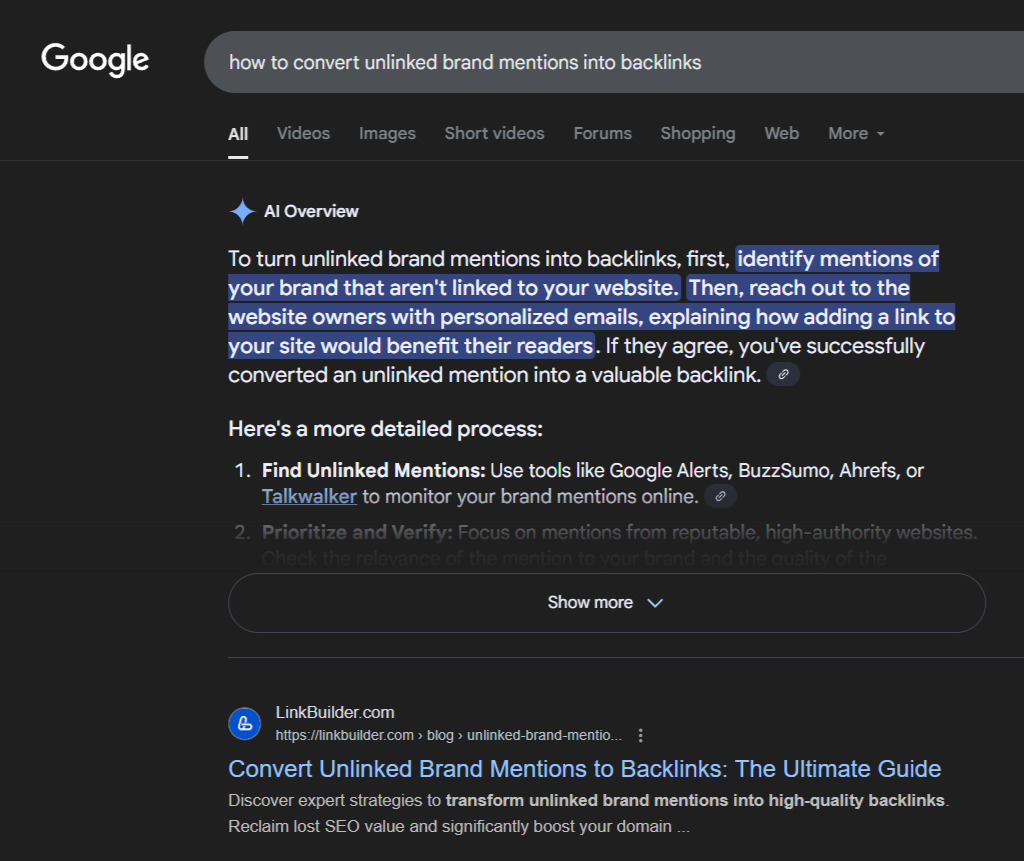
Optimizing Existing Content for AI
Structural Makeovers:
- Put key answers first (inverted pyramid style)
- Turn subheadings into questions
- Chunk content into digestible pieces
E-E-A-T Boosters:
- Add author credentials
- Link to authoritative sources
- Showcase real-world examples
Technical Polish:
- Implement HowTo/FAQ schema
- Optimize images for AI parsing
- Improve internal linking
Creating New AI-Optimized Content
When starting fresh:
- Research Differently
- Find unanswered questions in your niche
- Identify areas where you can add unique expertise
- Write for Both Humans and AI
- Clear, factual answers upfront
- Natural Q&A flow
- Multiple content formats (tables, steps, definitions)
- Promote for AI Visibility
- Strategic internal linking
- Earn quality backlinks
- Repurpose across platforms
Measuring and Optimizing GEO Performance
In the world of generative engine optimization, simply creating content isn't enough. You need concrete data to determine whether your engine optimization strategies are working – and that requires entirely new performance metrics.
New Success Metrics for the AI Search Era
Traditional SEO metrics no longer tell the whole story with AI search engine optimization. Now it's crucial to track not just rankings and clicks, but how your content appears in generative engine responses.
Leading platforms are already releasing tools for this. Semrush's AI Overview Tracking, for example, monitors appearances in AI-generated summaries.
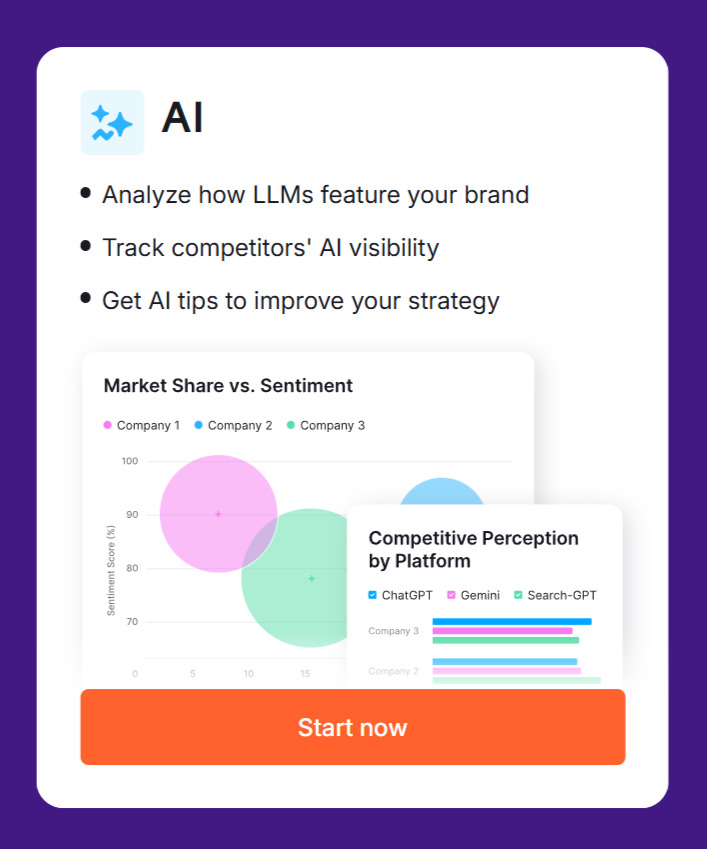
Key GEO digital marketing metrics now include:
- Citation frequency – How often your content appears in AI answers
- Attribution accuracy – Whether AI correctly credits your brand
- Content utilization – What percentage of your content gets referenced
- Brand visibility – How frequently your brand appears in responses
Unlike traditional SEO where ranking #1 was the goal, success in generative AI SEO means becoming AI's preferred information source – measured by how seamlessly your content integrates into helpful responses.
Tracking Your Generative Search Presence
Monitoring AI optimization performance requires new approaches:
- Specialized tracking tools
- Manual query testing
- Generative API analysis
- Traffic pattern monitoring
LinkBuilder.com's AI Ranker exemplifies this new category by:
- Analyzing search engine optimization content in AI responses
- Tracking which pages get cited
- Monitoring brand mentions
- Generating actionable reports
Common GEO Misconceptions

Myth 1: "AI just repackages top 10 results"
Reality: Modern generative models like Gemini and Claude analyze trillions of data points across the entire web – not just SERPs. They cross-reference information from academic papers, forums, news archives, and even multimedia sources to generate original responses. This means authoritative content beyond the first page can still earn visibility through AI search engine optimization.
Myth 2: "Keywords don't matter anymore"
Reality: While exact-match keywords have diminished importance, semantic relevance is now the cornerstone of generative AI SEO. AI understands user intent and contextual relationships between concepts. Effective AI content optimization focuses on topic clusters, natural language variations, and comprehensive coverage of subtopics rather than rigid keyword targeting.
Myth 3: "You need to write differently for AI"
Reality: The most successful GEO digital marketing content follows the same principles as good human writing – clarity, accuracy, and value. Google's helpful content guidelines apply doubly for generative engines. Focus on creating in-depth, well-structured content that genuinely helps users rather than trying to "game" AI systems with artificial formatting.
Myth 4: "Longer content always wins"
Reality: While thoroughness is important, generative models prioritize the most relevant information, regardless of its length. A 500-word search engine optimization content piece that directly answers a query often outperforms a 3,000-word article that buries key insights. Structure content with clear hierarchies (H2/H3), bullet points for key facts, and "answer-first" formatting for maximum impact in engine optimization services.
Common Pitfalls When Transitioning from SEO to GEO
When adapting traditional SEO strategies to meet generative engine requirements, businesses often make these critical mistakes:
- Neglecting structured data – As we've emphasized throughout this guide, schema markup becomes even more crucial for AI search engine optimization. It helps the generative engine accurately interpret and utilize your content.
- Overemphasizing keywords – Instead of keyword stuffing, focus on comprehensively answering user questions. This shift is fundamental to effective AI content optimization.
- Creating AI-only content – Remember that content must primarily serve human users. Modern generative engines can detect content created solely for algorithmic manipulation.
- Overlooking E-E-A-T principles – Experience, Expertise, Authoritativeness, and Trustworthiness remain equally vital in GEO digital marketing as in traditional SEO.
- Abandoning core ranking factors – Technical SEO, on-page optimization, and UX remain essential components of any search engine optimization solution.
Balancing AI Optimization and User Experience
Finding the proper equilibrium between AI optimization and human-centric design is the cornerstone of successful engine optimization strategies. Follow these principles:
- Answer real user questions – Content satisfying human queries naturally aligns with what generative engines seek to provide.
- Maintain clear structure – Logical organization benefits both human comprehension and AI's ability to extract precise information.
- Prioritize transparency – Avoid attempts to game the system; modern AI can easily detect such manipulation attempts.
- Don't neglect technical foundations – Page speed, mobile responsiveness, and intuitive navigation enhance both user experience and service engine optimization performance.
- Invest in quality visuals – While AI currently processes visual content differently than text, strong imagery improves engagement metrics.
Remember: What does GEO stand for in the long run? It represents the convergence of technical excellence and human-value creation. As AI evolves, algorithms will increasingly prioritize genuinely helpful content – making people-first creation the ultimate optimize engine strategy for sustainable visibility.
What is GEO's ultimate lesson? The most effective approach blends:
- Technical precision for generative engine compatibility
- Authentic expertise that satisfies E-E-A-T criteria
- User experience optimized for both humans and AI
This balanced methodology represents the future of AI search engine optimization, where satisfying human intent and technical excellence work in harmony.
Tailored GEO Digital Marketing Strategies by Business Type
E-Commerce: Optimization for Product Discovery
Online stores require specialized approaches. Key tactics include:
- Product Description Optimization
- Embed answers to common product questions
- Structure details for easy AI extraction (features/benefits/use cases)
- Include comparison data for context
- Category Content Hubs
- Develop comprehensive buying guides
- Feature expert recommendations likely to be cited
- Build detailed FAQ sections
- Enhanced Product Structured Data
- Implement rich Schema.org markup
- Display real-time pricing/availability/reviews
- Maintain meticulous data freshness
- Purchase Journey Clarity
- Detail checkout/shipping processes
- Differentiate your value proposition
Publishers: AI Content Optimization for Authority
Content sites must balance visibility with credibility:
- Extraction-Friendly Formatting
- Use question-style subheadings
- Highlight key stats and quotes
- Create scannable comparison tables
- Q&A Architecture
- Answer questions verbatim as users ask them
- Deliver concise, substantive responses
- Perfect for search engine optimization content
- E-E-A-T Reinforcement
- Involve subject matter experts
- Cite authoritative references
- Showcase author credentials
- Topical Cluster Development
- Interlink related content thematically
- Cover all subtopics comprehensively
- Use contextual internal linking
Local Businesses: Hyperlocal AI Search Engine Optimization
Brick-and-mortars need geo-aware strategies:
- Community-Centric Content
- Detail neighborhood specifics
- Cover local events/characteristics
- Local Schema Implementation
- Full LocalBusiness markup
- Complete service/operation details
- Precise location data
- GBP Synergy
- Maintain perfect profile accuracy
- Engage with customer interactions
- Post regular updates
- Voice Search Optimization
- Target "near me" conversational queries
- Use natural language patterns
B2B Solutions: Engine Optimization Strategies for Complex Offerings
Enterprise marketers should focus on:
- Concept Simplification
- Chunk complex information
- Create technical glossaries
- Case Study Development
- Structure client success stories
- Highlight measurable outcomes
- Decision-Stage Content
- Address vendor selection concerns
- Provide comparison frameworks
- Industry Leadership Signals
- Publish original research
- Offer expert commentary
The Future of GEO

AI-powered search is advancing fast – to future-proof your GEO approach, you need to stay ahead of these developments.
- Multimodal Search – Optimize engine compatibility across text/images/video
- Hyper-Personalization – Content must adapt to individual search contexts
- Fact Verification – Authoritative sourcing becomes non-negotiable
- Conversational Interfaces – Prepare for follow-up question depth
- Localized Understanding – Deep neighborhood expertise pays dividends
- Action-Oriented Results – Seamless integration with business systems
- Measurement Tools – New search engine optimization solution metrics for AI visibility
Invest now in structured, trustworthy content that serves both generative engines and human searchers equally well. The most successful strategies will blend technical precision with authentic expertise.
How to Choose the Right Partner for GEO Integration
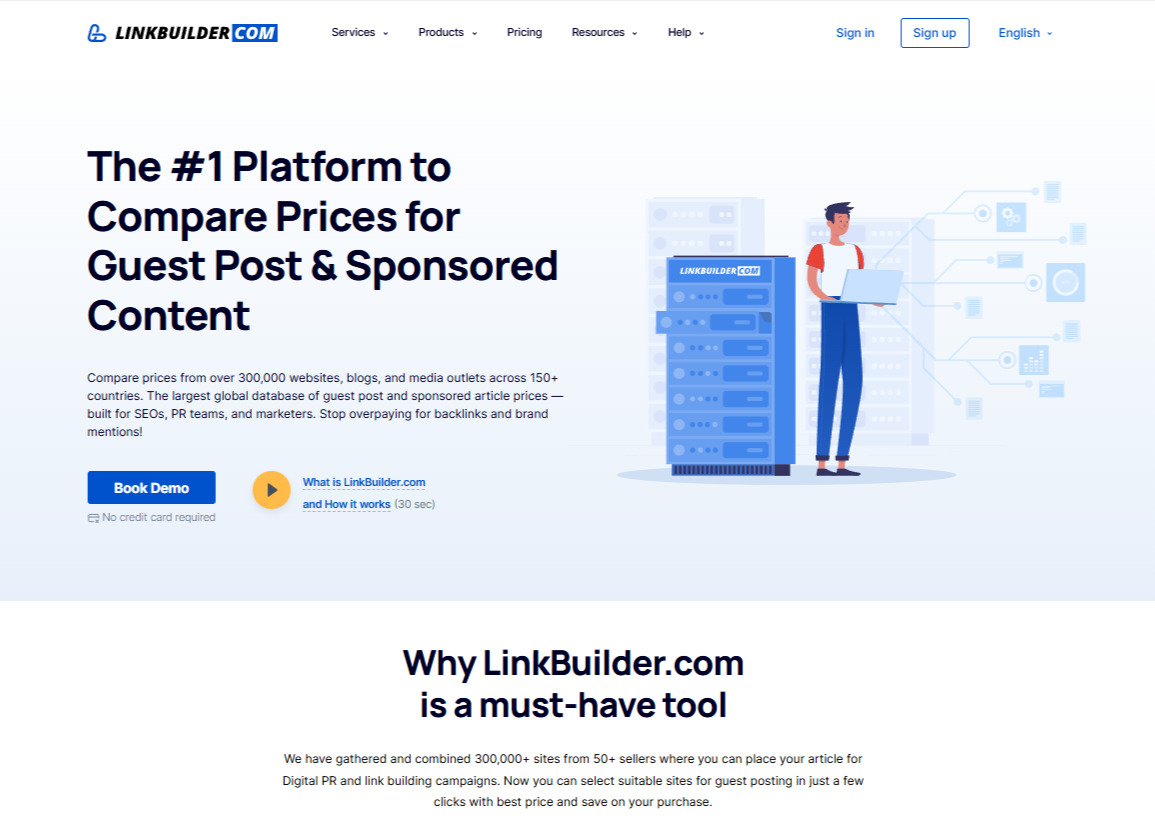
Finding the right partner to implement AI-powered SEO optimization is critical for success. Here's what to look for:
- Proven expertise in cutting-edge technologies
- Holistic digital marketing approach
- Comprehensive SEO solutions
- Specialized GEO tools
- Transparent communication and reporting
Why Choose LinkBuilder.com?
We provide full-service SEO optimization, including:
- AI Ranker – Our proprietary tool for tracking visibility in generative search results
- Expert team with deep SEO, content marketing, and AI knowledge
- Integrated strategy combining GEO with traditional SEO and other channels
- Transparent reporting with actionable metrics and regular updates
- Customized solutions tailored to your industry and business needs
The right GEO partner delivers more than just implementation – they provide long-term strategic planning. At LinkBuilder.com, we'll help you stay ahead in the evolving search landscape.








